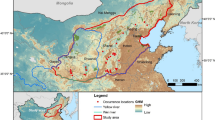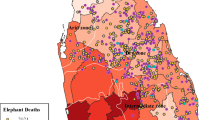Abstract
Evaluating the relationships between wildlife species and their habitats helps to predict effects of habitat change for present and future management of wild animal populations. Building ecological models are good ways to understand and manage wildlife populations and to predict various environmental scenarios. Recently, management of ungulates is becoming more important in Europe due to a high demand of hunting and their role in biodiversity. European roe deer (Capreolus capreolus) is the smallest species of cervids and has a widespread distribution in Turkey. In this study, two habitat suitability models of roe deers, living in the Black Sea Region in Turkey, were created by using a maximum entropy (MaxEnt) approach. Two wildlife development areas, which have widely different habitat types, were selected as study sites. As a result of this study, area under the curve (AUC) values were found to be above 0.80. According to the modeling results, in two different habitat types, ecological variables are quite similar in general. This study is the first study on modeling European roe deers in Turkey.













Similar content being viewed by others
References
Anonymous (2017). “Sinop Bozburun Yaban Hayatı Geliştirme Sahası”, Orman ve Su İşleri Bakanlığı, 10. Bölge Müdürlüğü Sinop İl Şube Müdürlüğü, Etüt Envanter Raporu, Sinop.
Baldwin, R. A. (2009). Use of maximum entropy modelling in wildlife research. Entropy, 11, 854–866. https://doi.org/10.3390/e11040854.
Barbet-Massin, M., Jiguet, F., Albert, C. H., & Thuiller, W. (2012). Selecting pseudo-absences for species distribution models: how, where and how many? Methods in Ecology and Evolution, 3(2), 327–338. https://doi.org/10.1111/j.2041-210X.2011.00172.x.
Byeon, D. H., Jung, S., & Lee, W. H. (2018). Review of CLIMEX and MaxEnt for studying species distribution in South Korea. Journal of Asia-Pacific Biodiversity. https://doi.org/10.1016/j.japb.2018.06.002.
Cunze, S., & Tackenberg, O. (2015). Decomposition of the maximum entropy niche function—a step beyond modelling species distribution. Environmental Modelling & Software, 72, 250–260.
Danilkin, A. (1996). Behavioural ecology of Siberian and European roe deer. Chapman & Hall.
De Angelis, A., Ricotta, C., Conedera, M., & Pezzatti, G. B. (2015). Modelling the meteorological forest fire niche in heterogeneous pyrologic conditions. PLoS One, 10(2), e0116875.
Dussault, C., Poulin, M., Courtois, R., & Ouellet, J. P. (2006). Temporal and spatial distribution of moose-vehicle accidents in the Laurentides Wildlife Reserve, Quebec, Canada. Wildlife Biology, 12(4), 415–426.
Elith, J., Phillips, S. J., Hastie, T., Dudík, M., Chee, Y. E., & Yates, C. J. (2011). A statistical explanation of MaxEnt for ecologists. Diversity and Distributions, 17(1), 43–57. https://doi.org/10.1111/j.1472-4642.2010.00725.x.
Ertuğrul, E. T., Mert, A., & Oğurlu, İ. (2017). Mapping habitat suitabilities of some wildlife species in Burdur Lake Basin. Turkish Journal of Forestry, 18(2), 149–154. https://doi.org/10.18182/tjf.330950.
Evcin, Ö. (2013). Karaca’nın (Capreolus capreolus) Kastamonu İlindeki Yayılışı ve Yaşam Alanlarının Belirlenmesi, Kastamonu University Institute of Science, MSc Dissertation, Kastamonu.
Evcin, Ö. (2018). Population ecology of roe deer (Capreolus capreolus) in Kastamonu and Sinop, Kastamonu University Institute of Science, PhD Dissertation, Kastamonu.
Gündoğdu, E. (2006). Isparta Yöresinde Yaban Keçisi (Capra aegagrus Erxleben 1777)’nin Populasyon Ekolojisi. Doktora Tezi. Süleyman Demirel Üniversitesi Fen Bilimleri Enstitüsü, Isparta.
Hanna, J., Warwell, M. V., Maffei, H., Fairweather, M. L., Blodgett, J. T., Zambino, Worrall, P J., Burns, Jacobs J., Richardson, B., Klopfenstein, N., Lundquist, J. E. (2016). Bioclimatic modeling predicts potential distribution of Armillaria solidipes and Pseudotsuga menziesii (Douglas-fir) under contemporary and changing climates in the interior western USA. In Proceedings of the 63rd Annual Western International Forest Disease Work Conference; September 21–25, 2015; Newport, OR. Olympia, WA: Washington Department of Natural Resources; Logan, UT: Utah State University, Quinney College of Natural Resources. pp. 117–123.
Harte, J., & Newman, E. A. (2014). Maximum information entropy: a foundation for ecological theory. Trends in Ecology & Evolution, 29(7), 384–389. https://doi.org/10.1016/j.tree.2014.04.009.
Harte, J., Zillio, T., Conlisk, E., & Smith, A. B. (2008). Maximum entropy and the state variable approach to macroecology. Ecology, 89(10), 2700–2711. https://doi.org/10.1890/07-1369.1.
Hernandez, P. A., Graham, C. H., Master, L. L., & Albert, D. L. (2006). The effect of sample size and species characteristics on performance of different species distribution modeling methods. Ecography, 29(5), 773–785. https://doi.org/10.1111/j.0906-7590.2006.04700.x.
Hernandez, P. A., Franke, I., Herzog, S. K., Pacheco, V., Paniagua, L., Quintana, H. L., Soto, A., Swenson, J., Tovar, C., Valqui, T. H., & Vargas, J. (2008). Predicting species distributions in poorly-studied landscapes. Biodiversity and Conservation, 17(6), 1353–1366.
Hobson, R. D. (1972). Surface roughness in topography: quantitative approach. In R. J. Chorley (Ed.), Spatial analysis in geomorphology (pp. 225–245). London: Metheur.
Jung, J. K., Lee, H., & Lee, J. H. (2014). Research status and future subjects to predict pest occurrences in agricultural ecosystems under climate change. Korean Journal of Agricultural and Forest Meteorology, 16(4), 368–383. https://doi.org/10.5532/KJAFM.2014.16.4.368.
Keten, A. (2017). Distribution and habitat preference of roe deer (Capreolus capreolus L.) in Düzce Province of Turkey. Journal of the Faculty of Forestry Istanbul University, 67(1), 22–28.
Khosravi, R., Hemami, M. R., Malekian, M., Flint, A., & Flint, L. (2016). Maxent modeling for predicting potential distribution of goitered gazelle in central Iran: the effect of extent and grain size on performance of the model. Turkish Journal of Zoology, 40(4), 574–585.
Kıraç, A., & Mert, A. (2019). Will Danford’s lizard become extinct in the future? Polish Journal of Environmental Studies, 28(3), 1741–1748.
Kleidon, A., Malhi, Y., & Cox, P. M. (2010). Maximum entropy production in environmental and ecological systems. Philosophical Transactions of the Royal Society, B: Biological Sciences, 365(1545), 1297–1302. https://doi.org/10.1098/rstb.2010.0018.
Krop-Benesch, A., Berger, A., Hofer, H., & Heurich, M. (2013). Long-term measurement of roe deer (Capreolus capreolus) (Mammalia: Cervidae) activity using two-axis accelerometers in GPS-collars. The Italian Journal of Zoology, 80(1), 69–81. https://doi.org/10.1080/11250003.2012.725777.
Kucuk, O., Evcin, O., & Aslan, F. (2017). Evaluating the frequency, dominance, resemblance analysis and diversity index of bird species in Ilgaz Mountain National Park. Fresenius Environmental Bulletin, 26(8), 5295–5304.
Kumar, S., Neven, L. G., Zhu, H., & Zhang, R. (2015). Assessing the global risk of establishment of Cydia pomonella (Lepidoptera: Tortricidae) using CLIMEX and MaxEnt niche models. Journal of Economic Entomology, 108(4), 1708–1719. https://doi.org/10.1093/jee/tov166.
Meisingset, E. L., Loe, L. E., Brekkum, Ø., Van Moorter, B., & Mysterud, A. (2013). Red deer habitat selection and movements in relation to roads. The Journal of Wildlife Management, 77(1), 181–191.
Merow, C., Smith, M. J., & Silander Jr., J. A. (2013). A practical guide to MaxEnt for modeling species’ distributions: what it does, and why inputs and settings matter. Ecography, 36(10), 1058–1069.
Mert, A., & Kirac, A. (2019). GIS as a tool to map habitat suitability for two lizard species using environmental factors. Fresenius Environmental Bulletin, 28(2A), 1330–1336.
Mert, A., & Yalcinkaya, B. (2017). Relationship between some wild mammals and forest structural diversity parameters. Journal of Environmental Biology, 38(5), 879–884.
Narouei-Khandan, H. A., Harmon, C. L., Harmon, P., Olmstead, J., Zelenev, V. V., van der Werf, W., Worner, S. P., Senay, D., & van Bruggen, A. H. C. (2017). Potential global and regional geographic distribution of Phomopsis vaccinii on Vaccinium species projected by two species distribution models. European Journal of Plant Pathology, 148(4), 919–930. https://doi.org/10.1007/s10658-017-1146-4.
Oğurlu, İ. (2001). Yaban Hayatı Ekolojisi. Isparta: Süleyman Demirel Üniversitesi Orman Fakültesi.
Oruç, M. S., Mert, A., & Özdemir, İ. (2017). Eskişehir Çatacık Yöresinde, Çevresel Değişkenler Kullanılarak Kızılgeyik İçin (Cervus elaphus L.) Habitat Uygunluğunun Modellenmesi. Bilge Uluslararası Fen ve Teknoloji Araştırmaları Dergisi, 1(2), 135–142.
Özkan, K. (2016). Bir meta bitki toplumunun kuantum analizi. İstanbul Üniversitesi Orman Fakültesi Dergisi, 66(1), 30–45.
Patton, D. R. (1992). Wildlife Habitat Relationships in Forested Ecosystems, Timber Pres., Portland, Oregon.
Payne, N., F, & Bryant, F. (1998). Wildlife Habitat Management of Forestlands, Krieger Publishing Company, USA.
Pearson, R. G., Raxworthy, C. J., Nakamura, M., & Townsend Peterson, A. (2007). Predicting species distributions from small numbers of occurrence records: a test case using cryptic geckos in Madagascar. Journal of Biogeography, 34(1), 102–117. https://doi.org/10.1111/j.1365-2699.2006.01594.x.
Phillips, S. J., Anderson, R. P., & Schapire, R. E. (2006). Maximum entropy modeling of species geographic distributions. Ecological Modelling, 190(3–4), 231–259. https://doi.org/10.1016/j.ecolmodel.2005.03.026.
Phillips, S. J., Dudík, M., Elith, J., Graham, C. H., Lehmann, A., Leathwick, J., & Ferrier, S. (2009). Sample selection bias and presence-only distribution models: implications for background and pseudo-absence data. Ecological Applications, 19(1), 181–197.
Preau, C., Trochet, A., Bertrand, R., & Isselin-Nondedeu, F. (2018). Modeling potential distributions of three European amphibian species comparing Enfa and Maxent. Herpetological Conservation and Biology, 13(1), 91–104.
Prior, R. (1995). The roe deer: conservation of a native species. Swan Hill.
Pueyo, S., He, F., & Zillio, T. (2007). The maximum entropy formalism and the idiosyncratic theory of biodiversity. Ecology Letters, 10(11), 1017–1028. https://doi.org/10.1111/j.1461-0248.2007.01096.x.
Slater, H., & Michael, E. (2012). Predicting the current and future potential distributions of Lymphatic filariasis in Africa using maximum entropy ecological niche modelling. PLoS One, 7(2), e32202. https://doi.org/10.1371/journal.pone.0032202.
Sobek-Swant, S., Kluza, D. A., Cuddington, K., & Lyons, D. B. (2012). Potential distribution of emerald ash borer: what can we learn from ecological niche models using Maxent and GARP? Forest Ecology and Management, 281, 23–31. https://doi.org/10.1016/j.foreco.2012.06.017.
Thomas, L., Buckland, S. T., Rexstad, E. A., Laake, J. L., Strindberg, S., Hedley, S. L., Bishop, J. R. B., Marques, T. A., & Burnham, K. P. (2010). Distance software: design and analysis of distance sampling surveys for estimating population size. Journal of Applied Ecology, 47, 5–14. https://doi.org/10.1111/j.1365-2664.2009.01737.x.
Waltert, M., Meyer, B., Shanyangi, M. W., Balozi, J. J., Kitwara, O., Qolli, S., Krischke, H., & Muehlenberg, M. (2008). Foot surveys of large mammals in woodlands of western Tanzania. Journal of Wildlife Management, 72, 603–610. https://doi.org/10.2193/2006-456.
Wu, W., Li, Y., & Hu, Y. (2016). Simulation of potential habitat overlap between red deer (Cervus elaphus) and roe deer (Capreolus capreolus) in northeastern China. PeerJ, 4, e1756. https://doi.org/10.7717/peerj.1756.
Xiao, X., McGlinn, D. J., & White, E. P. (2015). A strong test of the maximum entropy theory of ecology. The American Naturalist, 185(3), E70–E80. https://doi.org/10.1086/679576.
Zhang, K., Yao, L., Meng, J., & Tao, J. (2018). Maxent modeling for predicting the potential geographical distribution of two peony species under climate change. Science of the Total Environment, 634, 1326–1334. https://doi.org/10.1016/j.scitotenv.2018.04.112.
Acknowledgments
The authors are thankful to the Ministry of Agriculture and Forestry personnel for their contribution and efforts done for the field studies and to Dr. Ali Çelik and Dr. Erol Akkuzu for their support.
Funding
This work was supported by the Ministry of Agriculture and Forestry Protocol Project and Kastamonu University Scientific Research Projects Coordination Department (Project Number KÜ-BAP03/2015-6)
Author information
Authors and Affiliations
Corresponding author
Additional information
Publisher’s note
Springer Nature remains neutral with regard to jurisdictional claims in published maps and institutional affiliations.
Rights and permissions
About this article
Cite this article
Evcin, O., Kucuk, O. & Akturk, E. Habitat suitability model with maximum entropy approach for European roe deer (Capreolus capreolus) in the Black Sea Region. Environ Monit Assess 191, 669 (2019). https://doi.org/10.1007/s10661-019-7853-x
Received:
Accepted:
Published:
DOI: https://doi.org/10.1007/s10661-019-7853-x




